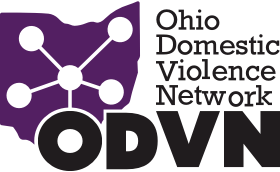Impact for Change: A New, DEI-centered Space
With the urgency of the day-to-day work trying to provide shelter and services for survivors of domestic violence in Ohio, there’s not always time to stop and consider directly issues of diversity, equity, and inclusion.
Over the past several years, the severity of domestic violence in Ohio has been growing more intense, with more incidents of intimate partner abuse, more severe injuries, and with situations becoming more lethal, often involving weapons. In 2022, member programs of the Ohio Domestic Violence Network (ODVN) helped nearly 10,000 people seeking emergency shelter, but turned away 36%—or one in three survivors—because the programs were at capacity.
That’s the big picture. But hidden within those statistics are other realities – including disparities in the experiences of Black women, other survivors of color, LGBTQ+ persons, immigrants, and survivors who are Deaf and Hard of Hearing as they seek safety and attempt to navigate the justice system.
As these survivors know well, they are not always viewed with compassion. Across the nation, there is evidence of systemic racism in policing and in criminal justice systems and a lack of trust. Lived experience and hard-won knowledge affects survivors’ willingness to trust that the systems they are being asked to interact with – from hospitals to police to courthouses to domestic violence agencies – are even capable of treating them fairly.
In an effort to focus more directly on issues involving equity, justice, and inclusion, ODVN is beginning a new blog called Impact for Change that will explore areas deserving of thought and attention – including examining systemic disparities and the role that institutionalized racism plays in that, ideas for doing better, and resources for digging deeper. It’s a place to think collectively about intersectionality – about the ways that intimate partner abuse intersects with the realities of racism and sexism, with gender identity, economic class, disabilities, religion, immigration status, and more.
This blog won’t cover everything – the subject is so complex. But it’s a start – a jumping-off point for much-needed conversation and training in local contexts, about issues with real implications both for domestic violence agencies and for the survivors we are trying to serve.
Here’s some of what we already know at ODVN about disparities.
In 2021, ODVN initiated a survey to learn more about the experience of survivors when seeking help—seeking particularly to understand whether women of color or survivors from other marginalized groups were experiencing difficulty accessing care, and in what ways.
In that survey, in which ODVN gathered responses from 588 domestic partner survivors across Ohio, about two-thirds of respondents reported being satisfied with their interactions with law enforcement, courts, and social service agencies. However, when there were problems, survivors of color, immigrants, and LGBTQ+ persons experienced those difficulties at significantly higher rates.
One example: When survivors said they were afraid to call 911, Black women and LGBTQ+ persons expressed that reluctance disproportionately – with about one-third of respondents from those groups saying they feared violence from the police. Survivors from those groups were more likely to report feeling disrespected by law enforcement, that their concerns were not taken seriously, that they felt blamed for what had happened. One survivor said: “They act like I deserved it … like I brought it on myself.”
Survivors of color were five times more likely than White survivors to say they believed their race or ethnicity was the reason the police treated them negatively.
While most survivors felt the courts took their concerns seriously, Black women were over-represented among those who were dissatisfied. Women of color said they felt court personnel did not take their concerns seriously 29% more than White survivors did. Deaf and Hard of Hearing survivors often were not provided interpreters when they called the police – which meant they sometimes were not separated from their abusers at the scene, and police had difficulty communicating with them directly.
Also, Child Protective Services (CPS) was more likely to be involved in the cases of survivors who were not White or heterosexual – with the rate of CPS involvement 21% higher for women of color than for White women, and 15% higher for LGBTQ+ parents.
In order to provide survivors of intimate partner violence with the services they need, it’s imperative that we understand the barriers they experience to accessing services. Among the suggestions:
- Have language interpreters at the scene with law enforcement officers or provide texting options for Deaf and Hard of Hearing survivors and for those for whom English is not their first language;
- Work for more diversity in the gender and race of responding officers. About three-quarters of the women of color ODVN surveyed who are parents said the race and gender identity of first responders was very important or somewhat important to their children’s feelings of safety.
- Provide specialized training in domestic violence issues for law enforcement. What survivors said they want most: Patience, empathy, fairness, compassion, to be listened to and believed.
Going forward, this blog will explore some of the language and concepts that are part of the broader diversity, equity and inclusion conversations, and look more closely at issues of particular concern regarding intimate partner violence and sexual assault. Some of this information might be familiar to you already; some might be new; some might be uncomfortable or challenging.
Our hope: the more we understand and take responsibility for what needs to change, the more we look at difficult issues with a willingness to learn and to name and confront systemic inequities, the better we can do our collective work on behalf of survivors. It’s hard. And it’s necessary.
Get in touch. Get involved.
174 E Long Street #200 Columbus, OH 43215
1.800.934.9840
614.781.9651
